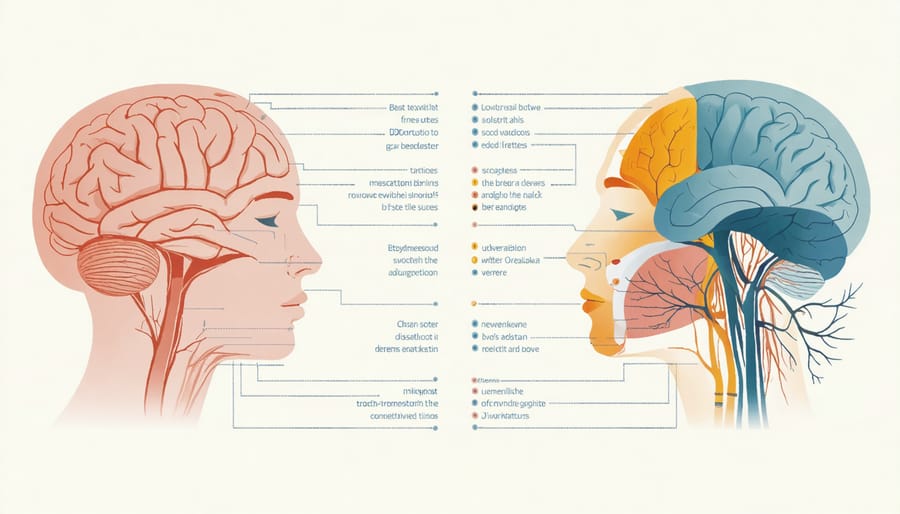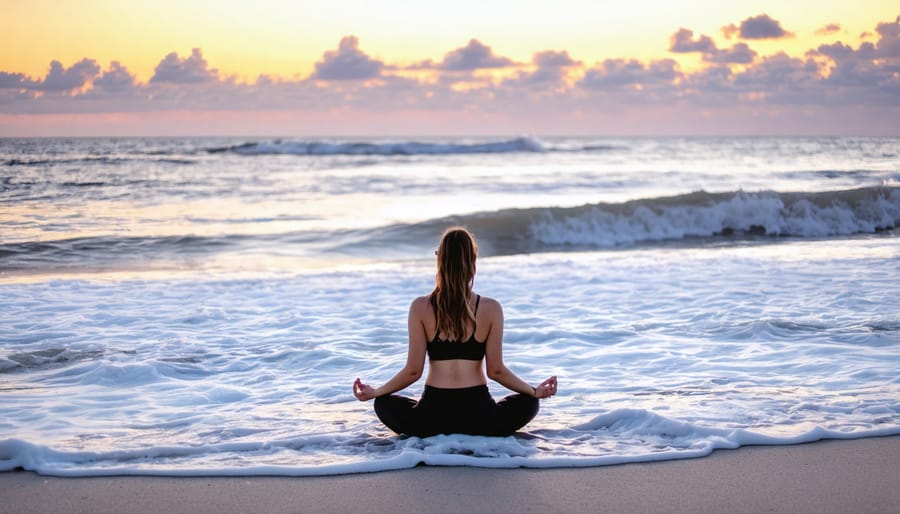Take control of anxiety with powerful breathing techniques that help you manage stress levels in minutes. When anxiety strikes, your breath becomes your most accessible and effective tool for immediate relief. Research shows that controlled breathing directly impacts your nervous system, triggering a natural relaxation response that calms both mind and body. Whether you’re facing a challenging workday, dealing with chronic stress, or experiencing a sudden wave of anxiety, these science-backed breathing exercises can help restore balance and bring peace of mind. The best part? These techniques are completely free, can be practiced anywhere, and require no special equipment or training. In the following guide, you’ll discover simple yet powerful breathing methods that thousands of Albertans already use to combat anxiety and reclaim their sense of calm.
How Breathing Affects Your Anxiety Response
The Science Behind Stress and Breathing
When you’re feeling anxious, your body’s stress response system kicks into high gear, triggering a cascade of physical reactions. Your heart rate increases, muscles tense up, and breathing becomes rapid and shallow. This is where conscious breathing comes into play.
Your breathing pattern directly influences your nervous system. Deep, slow breaths activate the parasympathetic nervous system – often called your body’s “rest and digest” mode. This naturally counteracts the fight-or-flight response that anxiety triggers.
When you breathe deeply, you send a signal to your brain that everything is okay. This triggers a relaxation response throughout your body: heart rate slows down, blood pressure decreases, and muscle tension eases. It’s like hitting a reset button for your stress levels.
The best part? This powerful mind-body connection is always available to you, completely free, and can be accessed anywhere, anytime.

Why Controlled Breathing Works
When you’re feeling anxious, your breathing typically becomes rapid and shallow, triggering your body’s stress response. Controlled breathing works by interrupting this cycle and activating your body’s natural relaxation system. Deep, intentional breaths send signals to your brain that you’re safe, which then prompts your body to lower stress hormones like cortisol and adrenaline.
This process engages your parasympathetic nervous system – often called the “rest and digest” mode – which naturally counteracts the “fight or flight” response that anxiety creates. By slowing your breath rate and breathing from your diaphragm, you increase oxygen flow to your brain and vital organs while reducing muscle tension and blood pressure.
Regular practice of controlled breathing strengthens this calming response, making it easier to manage anxiety over time. Think of it like building a muscle – the more you practice, the stronger and more effective your relaxation response becomes.
Essential Breathing Techniques for Immediate Calm
Box Breathing
Box breathing, also known as square breathing, is a simple yet powerful technique that can help calm your mind and reduce anxiety in just a few minutes. This method is used by everyone from healthcare workers to first responders, and it’s especially effective during stressful situations at work or home.
Here’s how to perform box breathing:
1. Find a comfortable position, either sitting upright in a chair with your feet flat on the floor or cross-legged on the ground.
2. Slowly exhale all the air from your lungs through your mouth.
3. Inhale slowly through your nose while counting to four. Feel your belly and chest expand.
4. Hold your breath for a count of four. Stay relaxed; don’t tense your muscles.
5. Exhale slowly through your mouth for a count of four, completely emptying your lungs.
6. Hold your breath again for a final count of four before starting the next cycle.
Repeat this pattern for 4-5 minutes, or until you feel calmer. You can practice box breathing anywhere – at your desk, in your car (while parked), or even while waiting in line at the grocery store.
Start with just a few minutes and gradually increase the duration as you become more comfortable with the technique. If counting to four feels too long or too short, adjust the count to what feels right for you while maintaining equal lengths for each phase.

Diaphragmatic Breathing
Diaphragmatic breathing, also known as belly breathing, is one of the most effective techniques for managing anxiety and promoting relaxation. When you breathe deeply into your belly, you activate your body’s natural relaxation response, helping to calm both your mind and body.
To practice diaphragmatic breathing, find a quiet spot and get into a comfortable position, either lying down or sitting with your back straight. Place one hand on your chest and the other on your belly, just below your rib cage.
Take a slow, deep breath through your nose, allowing your belly to expand like a balloon. You should feel the hand on your stomach rise while the hand on your chest remains relatively still. Hold this breath for a count of two.
Then, exhale slowly through slightly pursed lips, as if you’re gently blowing out a candle. Feel your belly lower as you release all the air. The key is to breathe deeply enough that your belly, not your chest, does the main work.
Start with 5-10 minutes of practice daily, ideally in the morning or when you first feel anxiety creeping in. Many Albertans find this technique particularly helpful during our long winters when we tend to spend more time indoors.
Remember, like any new skill, diaphragmatic breathing takes practice. Be patient with yourself as you develop this valuable relaxation tool.

4-7-8 Breathing
The 4-7-8 breathing technique, developed by Dr. Andrew Weil, is a powerful tool that can help calm your nervous system within minutes. Think of it as a natural tranquilizer for your mind and body.
Here’s how to perform this technique:
1. Find a comfortable position, either sitting up straight or lying down.
2. Place the tip of your tongue against the ridge behind your upper front teeth. Keep it there throughout the exercise.
3. Start by exhaling completely through your mouth, making a whoosh sound.
4. Close your mouth and inhale quietly through your nose for a count of 4.
5. Hold your breath for a count of 7.
6. Exhale completely through your mouth (making that whoosh sound) for a count of 8.
7. Repeat this cycle three more times, for a total of four breaths.
For best results, practice this technique twice daily. Many Albertans find it particularly helpful during our long winter months when seasonal stress is higher. While it might feel a bit challenging to hold your breath at first, the feeling becomes more natural with practice.
Remember to keep the ratio of 4:7:8 consistent, but you can speed up or slow down the counting as needed. If holding your breath for 7 counts feels too long initially, reduce the counts while maintaining the same proportions.
Start with just four cycles and gradually work your way up to eight cycles as you become more comfortable with the technique.
Making Breathing Exercises Part of Your Daily Routine
Creating a Breathing Practice Schedule
Creating a consistent breathing practice is key to managing anxiety effectively. Start by setting aside just 5-10 minutes each day, preferably at the same time. Many Albertans find early morning or evening works best, when the house is quiet and distractions are minimal.
Begin with three practice sessions per week and gradually increase to daily sessions as you become more comfortable. Set reminders on your phone or link your practice to existing habits, like having your morning coffee or getting ready for bed.
Keep a simple log to track your progress and note how you feel before and after each session. This helps identify patterns and motivates you to maintain the practice. Consider joining local wellness groups or community centers that offer guided breathing sessions – many Alberta health centers now include these in their wellness programs.
Remember, consistency matters more than duration. Even five minutes of focused breathing daily can make a significant difference in managing anxiety. If you miss a day, don’t worry – simply resume your practice the next day without guilt.
Using Breathing Techniques in Stressful Situations
When anxiety strikes, having a go-to breathing technique can help you regain control quickly. Start by recognizing early warning signs of stress, such as tension in your shoulders or racing thoughts. This awareness gives you a chance to use breathing exercises before anxiety escalates.
In meetings or public spaces, try the subtle 4-4-4 method: breathe in for four counts, hold for four, then release for four. This technique works well because it’s nearly invisible to others – no one needs to know you’re practicing it.
For immediate relief during intense moments, place one hand on your chest and the other on your belly. Take a deep breath through your nose, focusing on expanding your belly rather than your chest. This grounds you in your body and helps interrupt the stress response.
If you’re driving or stuck in traffic, try “red light breathing” – use each stop as a reminder to take three deliberate breaths. This transforms potentially frustrating moments into opportunities for calm.
Remember, these techniques work best when practiced regularly, not just during stressful times. Make them part of your daily routine to build your resilience against anxiety.
As we’ve explored throughout this article, breathing exercises are powerful tools for managing anxiety and promoting overall well-being. These simple yet effective techniques can be practiced anywhere, anytime, making them invaluable resources for your mental health toolkit.
Remember that the key to success with these breathing exercises lies in regular practice. Start with just a few minutes each day, perhaps during your morning routine or before bedtime. As you become more comfortable with these techniques, you’ll find it easier to use them during moments of stress or anxiety.
Whether you choose the 4-7-8 method, box breathing, or belly breathing, the most important thing is finding what works best for you. Each technique offers unique benefits, and you may find that different situations call for different approaches.
For our Alberta community members, consider incorporating these practices into your daily wellness routine, especially during our long winters when stress and anxiety can feel more pronounced. You might even want to join local meditation groups or wellness centers to practice these techniques with others.
Don’t get discouraged if you don’t notice immediate results – like any skill, breathing techniques take time to master. Be patient with yourself, stay consistent, and remember that every breath is an opportunity to find more peace and calm in your daily life.
Take that first step today. Your journey to better anxiety management through mindful breathing starts with a single breath.

